Voici les conditions de l’expérience:
– empilement type Schneebeli de cylindres de plexiglas
– compression unixiale verticale
– empilement entre polarisateurs croisés

Manipulation N°1
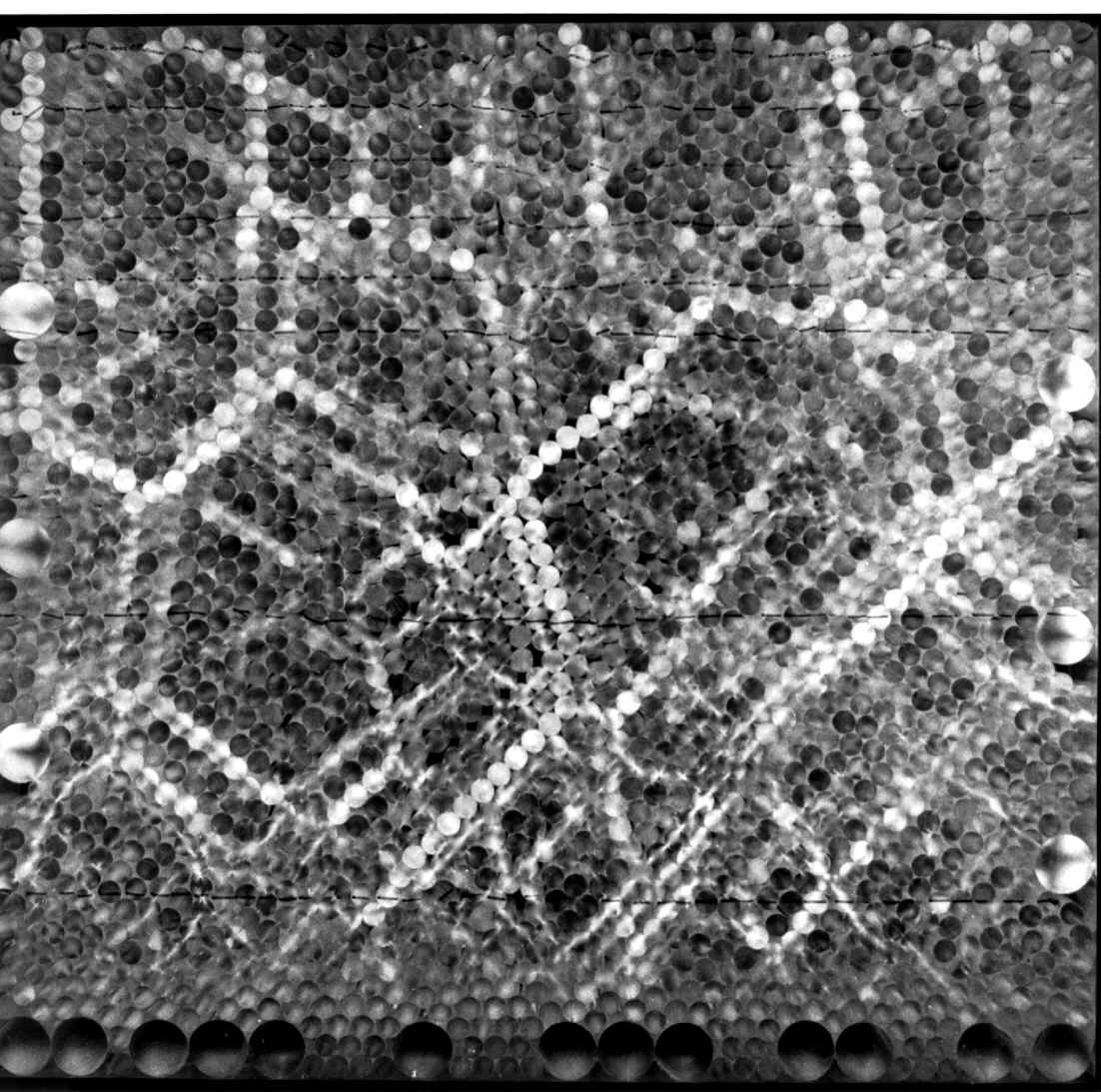
Manipulation N°2
Site professionnel de Luc Oger
Voici les conditions de l’expérience:
– empilement type Schneebeli de cylindres de plexiglas
– compression unixiale verticale
– empilement entre polarisateurs croisés

Manipulation N°1

Manipulation N°2
voici les conditions expérimentales :
– Les deux parois latérales sont constituées de plaques de plexiglass.
– Le fond est une plaque de verre
– l’inclinaison du plan est d’environ 30°
– les billes de verre sont monotailles et d’environ 250 µm
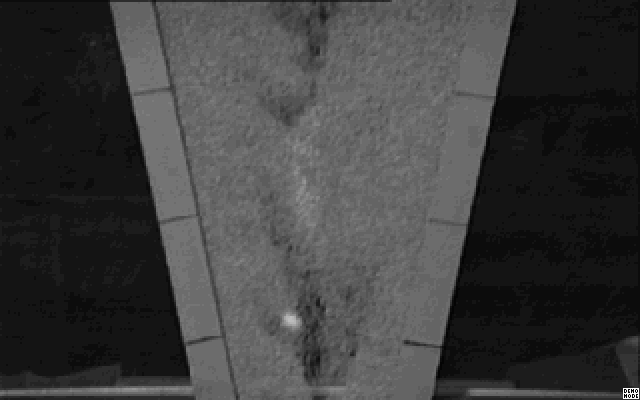
Manipulation N°1
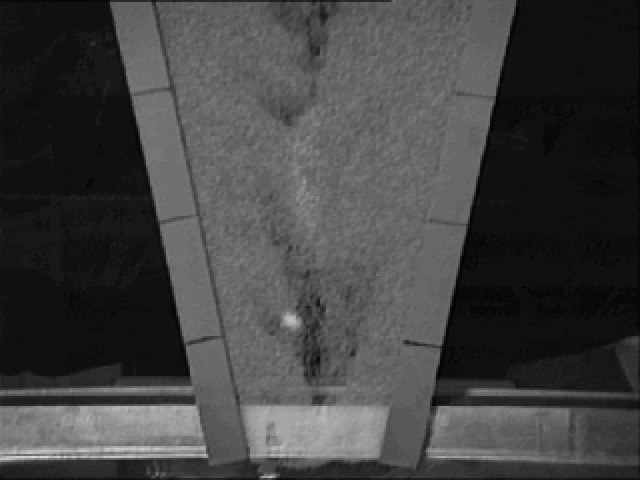
Manipulation N°2
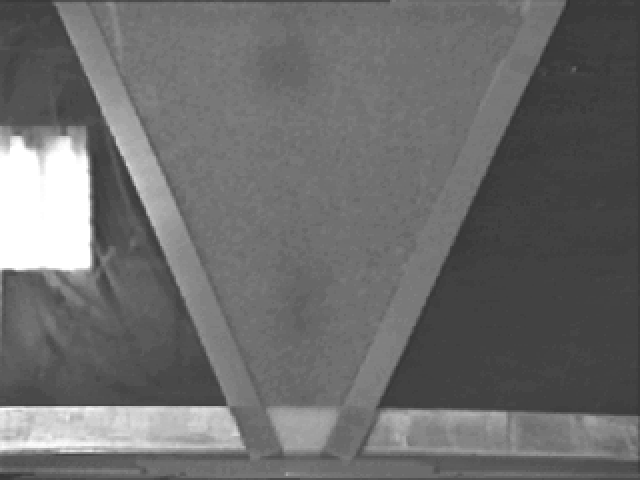
Manipulation N°3
L’empilement de disques comporte 64000 éléments rangés dans un récipient avec une condition périodique horizontale et un mur supérieure absorbant (vitesse nulle après impact).
Le fond de l’empilement est réalisé avec une condition d’amortisseur progressif rendant les grains de moins en moins mobiles en fonction de l’approche du bas du récipient.
Les couleurs correspondent aux vitesses horizontales de déplacement des grains.
Le transport de grains lors de la saltation est un phénomène essentiellement à trois dimensions et donc il est primordial de pouvoir aussi l’appréhender sous cet aspect tridimensionnel. Bien que la composante principale entrant dans le comportement collectif soit la composante verticale, les deux directions horizontales contribuent à la dispersion du phénomène ainsi qu’à son atténuation.
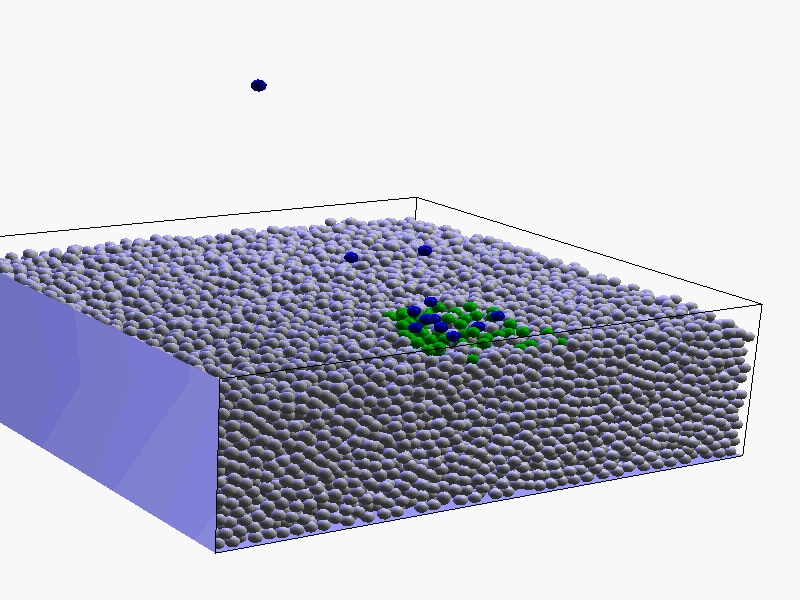
Lorsque plusieurs particules impactent le milieu granulaire dense avant que celui-ci est retrouvé son équilibre suite à un impact précédent il peut y avoir plus d’éjectas de former que la prévision émanant de la fonction « Splash » classique.
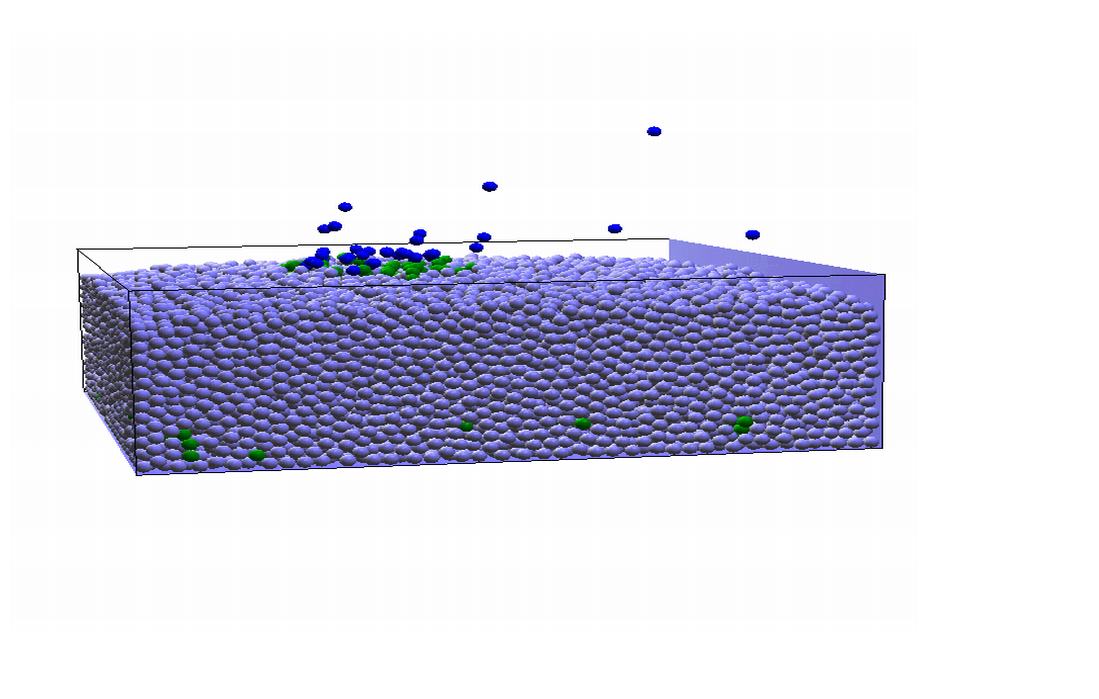
La manipulation de la matière en grains est souvent la source de nombreuses difficultés. L’une d’entre elles est la ségrégation de taille, qui implique une distribution non homogène des différents types de grains, ce qui rend très difficile la réalisation de mélanges homogènes. Durant le travail de thèse Francl Lominé, nous nous sommes intéressés au phénomène de percolation spontanée dans un milieu granulaire. Le phénomène de percolation spontanée est défini comme le mouvement de fines particules à travers un arrangement de sphères plus grosses sous le simple effet de la gravité. L’énergie est alors dissipée lors des collisions qui entraînent une dispersion longitudinale et transversale des particules. L’intérêt porté à la compréhension des phénomènes qui régissent ce type de transport trouve sa justification dans les problèmes rencontrés par les industries mettant en œuvre des matériaux granulaires (industrie pharmaceutique, génie civil …). Pouvoir pallier les phénomènes de ségrégation qui apparaissent lorsque l’on essaie de mélanger deux, voire plusieurs types de grains, est d’une importance primordiale dans les secteurs industriels précédemment cités.
De plus, un processus diffusif s’avère être un moyen simple et efficace pour obtenir des mélanges homogènes. Néanmoins, pour y parvenir, la connaissance de l’influence des différents paramètres qui interviennent est nécessaire. Nos recherches se sont articulées autour de deux axes complémentaires : une partie expérimentale et une partie numérique.
Dispositif expérimental
Le dispositif expérimental permettant l’étude du transport de petites particules à travers un milieu poreux, est constitué d’une cellule de plexiglass qui sert de support au milieu poreux. Ce milieu est modélisé par un empilement de billes de verre de diamètre D au-dessous duquel on place une balance piézoélectrique permettant une mesure très précise de l’évolution temporelle de la masse de matière à la sortie du milieu poreux. Nous disposons également, sous le milieu poreux, un réceptacle compartimenté permettant d’avoir accès aux positions des particules à la sortie du milieu poreux. Les particules injectées dans la structure poreuse sont des billes de diamètre d=1 mm choisi tel que l’on se place loin du seuil de capture géométrique. Plus d’informations sur ce seuil peuvent être trouvées ici. Ces petites particules sont initialement contenues dans un distributeur à ouverture verticale. Le distributeur est formé de cubes concentriques pour permettre un lâcher ponctuel quel que soit le nombre de particules. L’ouverture du distributeur est pilotée via un ordinateur et le signal émis par le piézoélectrique est recueilli, après amplification, via une carte d’acquisition.
Simulations numériques
Pour compléter l’étude expérimentale d’écoulement de particules à travers un milieu poreux, on utilise des codes de calculs basés sur les méthodes aux éléments discrets: dynamique moléculaire de sphères molles et dynamique moléculaire de sphères dures (Event-Driven). L’utilisation de la simulation numérique permet d’avoir aisément accès à l’intérieur de la matrice poreuse. Elle permet un contrôle total des paramètres physiques intervenant dans le processus de percolation et permet également la mesure de diverses grandeurs difficilement accessibles expérimentalement.
Pour modéliser cette expérience, il est nécessaire dans un premier temps de générer des empilements désordonnés de sphères via l »algorithme de Powell.
Pour la génération du milieu poreux, une légère dispersion de taille est introduite afin d’éviter la formation de zones localement ordonnées. Pour éviter que des particules restent piégées dans le milieu poreux, les simulations numériques, tout comme les expériences, sont réalisées au-delà du seuil de capture géométrique.
La partie dynamique de la simulation est traitée par une méthode de type dynamique moléculaire: la méthode des sphères molles. Cette méthode est très bien adaptée pour gérer nativement les contacts entre plusieurs particules. Du fait de la nécessité, dans cette méthode, d’intégrer temporellement les positions des particules, cette méthode est généralement plus couteuse en temps de calcul que la précédente. Pour y remédier, le code implémente alors plusieurs techniques d’optimisations telles que l’utilisation de plusieurs maillages et de listes de liens doublement liées pour une recherche optimale des partenaires des collisions. De plus, ce code est parallélisé via la librairie MPI (Message Passing Interface).
Les résultats de ces simulations sont en parfait accord avec les observations et mesures expérimentales. De plus, la simulation numérique permet de s’intéresser aux problèmes de mélanges et démélanges de particules.
2D channel on inclined plane
1 mm glass beads
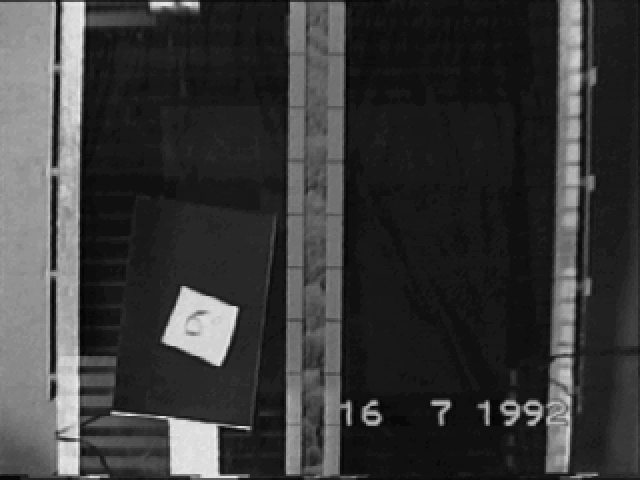
GENERAL CONDITIONS OF THE EXPERIMENT
– The two lateral walls are parallel and frictionless
– Free bottom exit
– Beads are initially displayed in a mono layer all along the full channel
Following my stay in the Department of Civil Engineering and Applied Mechanics from McGill University (Montreal, Canada) and my collaboration with SB Savage, we continued our studies on a numerical model of granular media subjected to cohesive forces (Model molecular dynamics). This model allows to describe exhaustively the micro interactions taking place between the grains. We used the laws of mechanical behavior typically allowed in these models. The grains may intersect and thus oppose a force proportional to the normal overlap but delayed by a carefully chosen shock (hence the name « Spring-Dashpot ») to avoid the effects of oscillations such as sound propagation .Similarly, the tangential forces are defined by a coefficient depending on sliding tangential grain and similarly depreciated. In addition, the tangential forces are governed by the Coulomb criterion when the contact is purely sec. The addition of cohesion forces can generate the tangential greater.
This model has thus to simulate the behavior of ice floes (ice block wide but thin) subject to the currents. By extension, in this model we can introduce elements consist of several grains which initially glued break under the action of external loads (due to shear currents, Coriolis, wind, etc. …..) but also elements that weld is under compression (agglomeration of ice blocks mechanically or thermally). These results are analyzed and modified according to parameters obtained from experiments « size » made in the centers of ice of Canada (NRC Newfoundland). Preliminary results on two-dimensional piles subjected to biaxial compression have showed that the overall coefficient of friction of a pile was almost constant irrespective of the value of the coefficient of friction between grains. This is in contradiction with the generally accepted theories in soil mechanics (Caquot, Bishop Rowe, etc …) have proposed a linear dependence between these two parameters. Similarly, the overall friction coefficient is never zero even if the value of the coefficient of friction between the grain is the geometric dimensions playing the role of low shear stresses.

Figure: Force displacement during a biaxial test with different values of confinement (between 20 and 200kPa).
We have shown that the friction coefficient increased with the overall growth of the distribution of grain sizes. . Indeed, the appearance of areas more or less geometrically ordered causes the transmission of contact forces over large correlation lengths and thus distorts the overall coefficient of friction (decrease). The anisotropic distribution of contact forces due to biaxial compression is not compensated by a uniform distribution of directions of these forces.
I participated in the development of measuring equipment on the two-phase flows by Nuclear Magnetic Resonance (NMR). NMR, being primarily a phenomenon dependent on the interfaces, is a very promising to link the physical properties multiphase environment to its geometric characteristics. For our part, we have developed in parallel several environments polyphasic approaches that allow to advance knowledge on the environments in several phases together with the techniques of NMR measurements that apply to them. Ainsi, nous avons étudié Thus, we studied
– the passage of a single-phase fluid flow in a pipeline of state to a turbulent regime (with a zone of interference),
– fluid consists of two phases in motion simultaneously (fluid-phase water and air bubbles, water and oil).
-fluid flow (or not) in a second phase consisting of a stationary porous medium
– fluid flow with glass beads by sustentées fluid (fluidized bed).
a) The study of the characteristics of a single-phase fluid flow in a pipe has been achieved through the establishment of a linear gradient magnetic field within a pulse spectrometer (Bruker CXP 100) and with pulse sequences of the type Carr-Purcell-Meiboom-Gill. The analysis of spin echo (synchronous detection and Fourier transformation) allows to obtain the distribution of velocity in the pipeline, the rms velocity fluctuations and a fairly complete information on the transverse and longitudinal dispersion of a fluid to flow speeds of 50 cm / s and average speed to values of 4 m / s. Additional studies allowed to observe intermittently during the passage of the flow of a laminar configuration with a configuration turbulent and thus to infer a rate of turbulence in the transition zone.
b) A study on two-phase flows (water-air) was achieved by creating or bubble flow finely dispersed or annular flow or mist type flows. In our study we are interested especially in case of air bubbles of various sizes moving at the same time as the water. We have highlighted the effect of bubbles, their size and density on development of the turbulence observed in the liquid. Indeed, even in the presence of a liquid flowing very slowly (ie it would be laminar if traveling single phase) the presence of a small amount of fine air bubbles mixing leads to turbulence. Our theoretical approach to the problem allowed us to resolve the difficulties inherent in these environments particularly unstable over time. We were able to measure the level of vacuum through the air-water mixture and the average speed of flow of the liquid phase. Moreover, the distribution of velocity of flow gave us the means to characterize the turbulence of the environment.
c) A third very promising study was conducted on the porous model consisting of stacks of glass beads of different sizes sintered. These materials have the advantage of being very well known both experimentally (porosity, permeability, hydrodynamic dispersion, mercury porosimetry) and theoretically (model of hard spheres Bernal, models or random Dodds). We can correlate the NMR studies on the average size and distribution of pore sizes for other possible methods (studies cited above). In addition, we can infer the specific surface of our materials (Report on volume of surface pores) which can be compared to measures of adsorption and capillary stereology (very classical). So we can infer the size distribution of pores in the case of real materials and compare to other possible approaches. This led to the development of a tool « logging » Schlumberger oil. Another study with a more dynamic aspect is related to the presence of a fluid in laminar or turbulent flow within the porous medium and has been the subject of the thesis defended in L. Lebon February 1996.
d) We also used the existing pulse sequences to study the behavior of a fluidized bed consisting of glass beads of varying diameter (between 100 and 800 m) moving in a liquid flow. We have highlighted a difference in behavior in a water-air flow and a fluidized bed. The first distribution has a speed close to that of a turbulent flow while the second seems to remain laminar. Measurements of rate of the liquid phase according to the fluid flow velocity are in very good agreement with experiments using mitigation of optical beam. The measures of local average velocity of the fluid and the velocity distribution was obtained in the case of low-flow Reynolds number. These measures coupled with measurements made elsewhere on the fluctuations of particle velocities can be traced back to the strength of interaction between the fluid phase and solid phase. A satisfactory description of this inter-phase force is one of the unsolved problems of modeling of dispersed two-phase media.
Granular media real 2D and 3D show the characteristic of being difficult to analyze in terms of contacts between grains because it is often imprecise (contact time is not even a numerical point of view). These neighborhood problems can be solved by our programs Voronoi tessellation For many years we have developed algorithms to analyze the spatial geometry of stacks of grain in two dimensions. We can completely paved space by polygons whose sides are defined by the radical axis between two neighboring grains.This paving is unique and each polygon contains only one grain. All the topological and metric properties of these structures has been analyzed in two dimensions. We recently extended this study to three dimensions.
This achievement enables us to study the topological and metric properties of granular media « real » and the 3D foam. The achievement of homogeneous stacks in three dimensions application to take into account a number of considerations such as steric effects or exclusion, the periodic conditions and more generally the history of the development (individually or collectively). We studied beaches compact easily achievable according to the numerical methods used. Algorithms Poisson, RSA (Random Sequential Adsorption), Powell and de Visscher and Bölsterli place a sphere after another permanently; algorithm Jodrey and Tory or modified by Jullien allows densification by rearrangement almost static and collectively. SPH algorithms, PIC, MD and ED are dynamic and take into account interactions between the spheres collisionnelles. We can scan the whole range of porosity (0 to 0.7405).
As a first step, we analyzed the properties of disordered stacks of spheres monotailles. We confirmed the validation of three-dimensional relationships Aboav-Weaire on average faces of the cells. To find the maximum possible stacks of our disorderly, we analyzed the structures slightly disturbed crystalline stacks of classics (in Faces Centered Cubic and Hexagonal Compact). A weak disorder (about 0.1%) in the structure increased the average number of neighbors of 12 to 14 directly.
We analyzed the dependencies of the distributions of numbers of faces and neighbors in terms of compactness of the pile. To do this, we had to generate different types of stacks (different « stories »), such as RSA (C = 0 to 30%), « dense packing » type or Powell and Bölsterli Visscher (C = 60-64%), Dynamics Molecular & Event-Driven (C = 0 to 60%) or Jullien (C = 40 to 64%). We have seen that this could influence some geometric parameters such as average number of faces and its distribution.This has the advantage of power used as criteria of disorder or order from existing stacks (by measuring the difference in solving random type RSA).Our models have been extended to cases where the binary and polydisperse. Figure 13 shows a difference of behavior for compactness greater than or less than 0.5 and according to the original configuration of the pile. The spheres of stacks originating with a CFC or HC have suffered a « thermal agitation » Event-Driven Model. This gave them a disorderly character for small compact car similar to the results obtained from the stacks type Jullien. As against over 0.5, the order inherent in the original structure is partially preserved and thus affects the outcome.
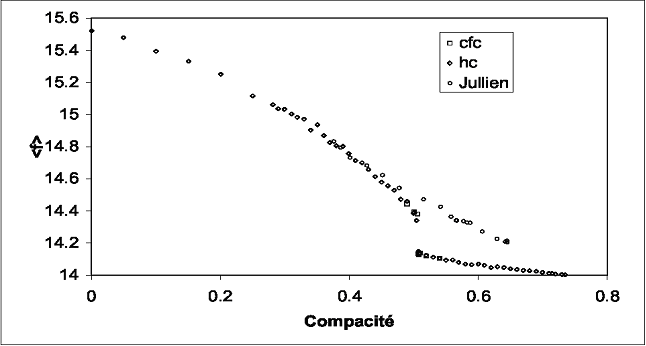
Figure: Evolution of average number of faces of Voronoi cells based on compactness. The initial (before reduction of the radii and agitation) are stacks of face-Centered Cubic (FCC) Hexagonal Compact (HC) or disordered (Jullien).
We then sought to understand how moving a stack initially disordered when subjected to thermal agitation. To do this we analyzed the importance of an order parameter (Q 6) which takes into account the spatial orientation of the various links connecting the sphere to its neighbors as defined by the Voronoi cell, we have also highlighted the evolution of the phase transitions between disordered (C <49.5%), a transition zone (49.5%
As the dominant structure is the CFC, we felt it appropriate to apply the basic principles of percolation to see how this structure evolved during the crystallization. So we followed the emergence and growth of CFC cell clusters at stirring of a disordered stacking of spheres initially monotailles compactness with more than 0545. As expected, there appeared a large number of mini cells CFCs that are organized to create a cluster of percolation through the entire structure.
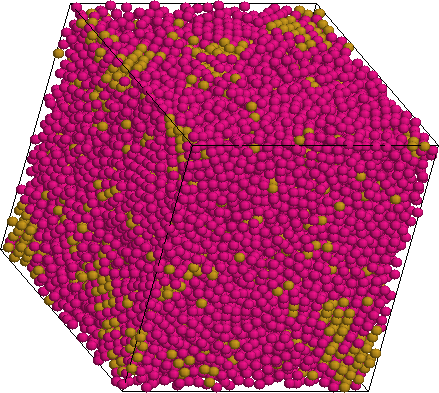
(a)

(b)
Figure: Crystallisation of a disordered stacking of spheres monotailles (a) subject to a uniform thermal agitation after 10 binary collisions 9 (b). The colors represent the areas being quasi-crystalline environment.
It is very easy to study numerically the three-dimensional stacks of objects but it is much more difficult to carry out similar studies experimentally. Few practical techniques used to obtain information experimental studies on the surface, measurements tomography, magnetic resonance imaging, liquid iso-index without being destructive. The most conventional is to practice cutting, serial or random 3D structure in order to obtain relevant information. We therefore sought to verify that it was the reliability of certain interpretations of measurements made on a cut based on the true three-dimensional measurement. Thus we compared the results of conventional 2D Voronoi tessellations and 3D obtained from a 3D stack cut by a plane or from a cut made in the 3D tessellation of the original structure.


Figure: 2D Voronoi tessellations obtained from a 3D stack cut by a plane and a cut made in the 2D tessellation 3D initial structure.
Welcome on board to my new web site
Since several years, I was trying to modify and update my web site in order to reflect my new research interest. But as usual time is flying very quickly and this action was not the most important…
But finally it comes!!!
I hope that all the information shown here will help you to discover the world of granular media, for static or dynamic studies